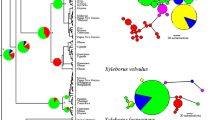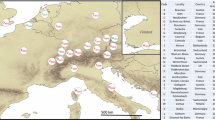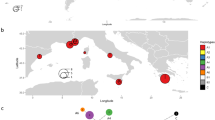Abstract
Xyleborine ambrosia beetles (Coleoptera: Scolytinae: Xyleborini) are among the most important and destructive pests in forests, tree nurseries and plantations worldwide. Their cryptic lifestyle, fungal mutualism, inbreeding and broad host range have predisposed them to become remarkably successful invaders and colonize novel habitats across the world. The black timber bark beetle, Xylosandrus germanus (Blandford), is native to East Asia, but now established in North America and Europe. It is an economically significant invasive pest in North American nurseries and orchards, and European forests. Managing and preventing the spread of exotic species such as X. germanus requires an understanding of invasion pathways and mechanisms associated with their source populations. In this study, we sequenced the mitochondrial gene COI and nuclear gene ArgK from six native and 24 non-native X. germanus populations to identify their origins. The genetic structure of X. germanus in non-native habitats is highly uniform and points to introductions from Honshu and/or Hokkaido, Japan. However, different haplotypes of the inferred Japanese source lineage, which dominate in North America and Europe today, together with temporal incidence of records of X. germanus indicate that these continents were invaded independently. While European populations were probably introduced only once prior to 1951, the genetic pattern of North American populations suggests that X. germanus was introduced several times.




Similar content being viewed by others
References
Agnello AM, Breth DI, Tee EM, Cox KD, Villani SM, Ayer KM, Wallis AE, Donahue DJ, Combs DB, Davis AE, Neal JA, English-Loeb FM (2017) Xylosandrus germanus (Coleoptera: Curculionidae: Scolytinae) occurrence, fungal associations, and management trials in New York apple orchards. J Econ Entomol 110:2149–2164. https://doi.org/10.1093/jee/tox189
Barbieri K, Keshk OMG (2016) Correlates of War Project data set codebook, version 4.0. https://correlatesofwar.org. Accessed 13 August 2020
Batra LR (1963) Ecology of ambrosia fungi and their dissemination by beetles. Trans Kans Acad Sci 66:213–236. https://doi.org/10.2307/3626562
Bellard C, Cassey P, Blackburn TM (2016) Alien species as a driver of recent extinctions. Biol Lett 12:20150623. https://doi.org/10.1098/rsbl.2015.0623
Brockerhoff EG, Liebhold AM, Jactel H (2006) The ecology of forest insect invasions and advances in their management. Can J For Res 36:263–268. https://doi.org/10.1139/x06-013
Cognato AI, Rubinoff D (2008) New exotic ambrosia beetles found in Hawaii (Curculionidae: Scolytinae: Xyleborina). Coleopt Bull 62:421–424
Coyle DR, Booth DC, Wallace MS (2005) Ambrosia beetle (Coleoptera: Scolytidae) species, flight, and attack on living eastern cottonwood trees. J Econ Entomol 98:2049–2057. https://doi.org/10.1093/jee/98.6.2049
Darriba D, Taboada GL, Doallo R, Posada D (2012) jModelTest 2: more models, new heuristics and parallel computing. Nat Methods 9:772. https://doi.org/10.1038/nmeth.2109
Devine R (1998) Alien invasions. National Geographic Society, Washington DC
Dole SA, Jordal BH, Cognato AI (2010) Polyphyly of Xylosandrus Reitter inferred from nuclear and mitochondrial genes (Coleoptera: Curculionidae: Scolytinae). Mol Phylogenetics Evol 54:773–782. https://doi.org/10.1016/j.ympev.2009.11.011
Evans EA, Crane J, Hodges A, Osborne JL (2010) Potential economic impact of laurel wilt disease on the Florida avocado industry. Horttechnology 20:234–238. https://doi.org/10.21273/HORTTECH.20.1.234
Excoffier L, Lischer HEL (2010) Arlequin suite ver 3.5: a new series of programs to perform population genetics analyses under Linux and Windows. Mol Ecol Resour 10:564–567. https://doi.org/10.1111/j.1755-0998.2010.02847.x
Felt EP (1932) A new pest in greenhouse grown grape stems. J Econ Entomol 25:418
Galko J, Dzurenko M, Ranger CM, Kulfan J, Kula E, Nikolov C, Zúbrik M, Zach P (2019) Distribution, habitat preference, and management of the invasive ambrosia beetle Xylosandrus germanus (Coleoptera: Curculionidae, Scolytinae) in European forests with an emphasis on the West Carpathians. Forests 10:10. https://doi.org/10.3390/f10010010
Garrick RC, Bonatelli IAS, Hyseni C, Morales A, Pelletier TA, Perez MF, Rice E, Satler JD, Symula RE, Thomé MTC, Carstens BC (2015) The evolution of phylogeographic data sets. Mol Ecol 24:1164–1171. https://doi.org/10.1111/mec.13108
Gomez DF, Rabaglia RJ, Fairbanks KEO, Hulcr J (2018) North American Xyleborini north of Mexico: a review and key to genera and species (Coleoptera, Curculionidae, Scolytinae). ZooKeys 768:19–68. https://doi.org/10.3897/zookeys.768.24697
Grégoire JC, Piel F, De Proft M, Gilbert M (2001) Spatial distribution of ambrosia-beetle catches: a possibly useful knowledge to improve mass-trapping. Integrated Pest Manag Rev 6:237–242. https://doi.org/10.1023/A:1025723402355
Groschke F (1953) Der „schwarze nutzholzborkenkäfer”, Xylosandrus germanus Blandf., ein neuer schädling in Deutschland1). Z Angew Entomol 34:297–302. https://doi.org/10.1111/j.1439-0418.1953.tb00698.x
Haack RA (2001) Intercepted Scolytidae (Coleoptera) at U.S. ports of entry: 1985–2000. Integrated Pest Manag Rev 6:253–282. https://doi.org/10.1023/A:1025715200538
Haack RA (2006) Non-native bark- and wood-boring Coleoptera in the United States: recent establishments and interceptions. Can J For Res 36:269–288. https://doi.org/10.1139/x05-249
Huang D, Haack RA, Zhang R (2011) Does global warming increase establishment rates of invasive alien species? A centurial time series analysis. PLoS ONE 6:e24733. https://doi.org/10.1371/journal.pone.0024733.t002
Hulcr J, Stelinski LL (2017) The ambrosia symbiosis: from evolutionary ecology to practical management. Annu Rev Entomol 62:285–303. https://doi.org/10.1146/annurev-ento-031616-035105
Hulme PE (2009) Trade, transport and trouble: managing invasive species pathways in an era of globalization. J Appl Ecol 46:10–18. https://doi.org/10.1111/jpe.2009.46.issue-1
Ito M, Kajimura H, Hamaguchi K, Araya K, Lakatos F (2008) Genetic structure of Japanese populations of an ambrosia beetle, Xylosandrus germanus (Curculionidae: Scolytinae). Entomol Sci 11:375–383. https://doi.org/10.1111/j.1479-8298.2008.00280.x
Ito M, Kajimura H (2017) Landscape-scale genetic differentiation of a mycangial fungus associated with the ambrosia beetle, Xylosandrus germanus (Blandford) (Curculionidae: Scolytinae) in Japan. Ecol Evol 7:9203–9221. https://doi.org/10.1002/ece3.3437
IUCN (2000) Guidelines for the prevention of biodiversity loss caused by alien invasive species. Species Survival Commission, IUCN, Gland, Switzerland
Jordal BH, Beaver RA, Kirkendall LR (2001) Breaking taboos in the tropics: incest promotes colonization by wood-boring beetles. Glob Ecol Biogeogr 10:345–357. https://doi.org/10.1046/j.1466-822X.2001.00242.x
Jordal BH, Cognato AI (2012) Molecular phylogeny of bark and ambrosia beetles reveals multiple origins of fungus farming during periods of global warming. BMC Evol Biol 12:133. https://doi.org/10.1186/1471-2148-12-133
Kamp HD (1968) Schwarze nutzholzborkenkäfer. Xylosandrus germanus Blandf., ein neuling der heimischen insektenfauna. Entomologische Blätter 64:31–39
Karpun YuN (1998) Sokrovishcha parkov Sochi [The treasures of Sochi parks]. Sochi. (in Russian).
Kibar AK, Saruhan İ, Tuncer C, Akyol H, Kiliç A (2011) Ambrosia beetles (Coleoptera: Scolytidae) species and their damage ratios in kiwi orchards of Ordu province, Turkey. Türkiye Entomoloji Bülteni 1:229–234
LaBonte JR, Mudge AD, Johnson KJR (2005) Nonindigenous woodboring Coleoptera (Cerambycidae, Curculionidae: Scolytinae) new to Oregon and Washington, 1999–2002: consequences of the intracontinental movement of raw wood products and solid wood packing materials. Proc Entomol Soc Wash 107:554–564
Lakatos F, Kajimura H (2007) Occurrence of the introduced Xylosandrus germanus (Blandford, 1894) in Hungary-a genetic evidence (Coleoptera: Scolytidae). Folia Ent Hung 68:97–104
Lantschner MV, Corley JC, Liebhold AM (2020) Drivers of global Scolytinae invasion patterns. Ecol Appl. https://doi.org/10.1002/eap.2103
Le Roux J, Wieczorek AM (2009) Molecular systematics and population genetics of biological invasions: towards a better understanding of invasive species management. Ann Appl Biol 154:1–17. https://doi.org/10.1111/j.1744-7348.2008.00280.x
Lees DC, Lack HW, Rougerie R, Hernandez-Lopez A, Raus T, Avtzis ND, Augustin S, Lopez-Vaamonde C (2011) Tracking origins of invasive herbivores through herbaria and archival DNA: the case of the horse-chestnut leaf miner. Front Ecol Environ 9:322–328. https://doi.org/10.1890/100098
Mack RN, Simberloff D, Lonsdale WM, Evans H, Clout M, Bazzaz FA (2000) Biotic invasions: causes, epidemiology, global consequences, and control. Ecol Appl 10:689–710. https://doi.org/10.1890/1051-0761(2000)010[0689:BICEGC]2.0.CO;2
Maksymov JK (1987) Erstmaliger massenbefall des schwarzen nutzholzborkenkäfers, Xylosandrus germanus Blandf., in der Schweiz. Schweiz Z Forstwes 138:215–227
Mandelshtam MJ (2001) New synonymy and new records in Palaearctic Scolytidae (Coleoptera). Zoosyst Ross 9:203–204
Mandelshtam MY, Yakushkin EA, Petrov AV (2018) Oriental ambrosia beetles (Coleoptera: Curculionidae: Scolytinae): new inhabitants of Primorsky Krai in Russia. Russ J Biol Invasions 9:355–365. https://doi.org/10.1134/S2075111718040082
McCullough DG, Roberts DL (2002) Emerald ash borer. Pest Alert NA-PR-07–02, USDA Forest Service, Northeastern Area, State and Private Forestry.
Meurisse N, Rassati D, Hurley BP, Brockerhoff EG, Haack RA (2019) Common pathways by which non-native forest insects move internationally and domestically. J Pest Sci 92:13–27. https://doi.org/10.1007/s10340-018-0990-0
Oliver JB, Mannion CM (2001) Ambrosia beetle (Coleoptera: Scolytidae) species attacking chestnut and captured in ethanol-baited traps in middle Tennessee. Environ Entomol 30:909–918. https://doi.org/10.1603/0046-225X-30.5.909
Peer K, Taborsky M (2004) Female ambrosia beetles adjust their offspring sex ratio according to outbreeding opportunities for their sons. J Evol Biol 17:257–264. https://doi.org/10.1111/j.1420-9101.2003.00687.x
Peer K, Taborsky M (2005) Outbreeding depression, but no inbreeding depression in haplodiploid ambrosia beetles with regular sibling mating. Evolution 59:317–323. https://doi.org/10.1111/j.0014-3820.2005.tb00992.x
Ploetz RC, Hulcr J, Wingfield MJ, De Beer ZW (2013) Destructive tree diseases associated with ambrosia and bark beetles: black swan events in tree pathology? Plant Dis 97:856–872. https://doi.org/10.1094/PDIS-01-13-0056-FE
Ranger CM, Reding ME, Schultz PB, Oliver JB, Frank SD, Addesso KM, Chong JH, Sampson B, Werle C, Gill S, Krause C (2016) Biology, ecology, and management of nonnative ambrosia beetles (Coleoptera: Curculionidae: Scolytinae) in ornamental plant nurseries. J Integr Pest Manag 7:1–23. https://doi.org/10.1093/jipm/pmw005
Reding ME, Ranger CM, Sampson BJ, Werle CT, Oliver JB, Schultz PB (2015) Movement of Xylosandrus germanus (Coleoptera: Curculionidae) in ornamental nurseries and surrounding habitats. J Econ Entomol 108:1947–1953. https://doi.org/10.1093/jee/tov174
R Core Team (2018) R Foundation for statistical computing. Austria, Vienna
Rassati D, Faccoli M, Battisti A, Marini L (2016) Habitat and climatic preferences drive invasions of non-native ambrosia beetles in deciduous temperate forests. Biol Invasions 18:2809–2821. https://doi.org/10.1007/s10530-016-1172-8
Seebens H, Blackburn T, Dyer E, Genovesi P, Hulme PE, Jeschke JM, Pagad S, Pyšek P, Winter M, Arianoutsou M, Bacher S, Blasius B, Brundu G, Capinha C, Celesti-Grapow L, Dawson W, Dullinger S, Fuentes N, Jäger H, Kartesz J, Kenis M, Kreft H, Kühn I, Lenzner B, Liebhold A, Mosena A, Moser D, Nishino M, Pearman D, Pergl J, Rabitsch W, Rojas-Sandoval J, Roques A, Rorke S, Rossinelli S, Roy HE, Scalera R, Schindler S, Štajerová K, Tokarska-Guzik B, van Kleunen M, Walker K, Weigelt P, Yamanaka T, Essl F (2017) No saturation in the accumulation of alien species worldwide. Nat Commun 8:14435. https://doi.org/10.1038/ncomms14435
Siegert NW, McCullough DG, Liebhold AM, Telewski FW (2009) Reconstruction of the establishment and spread of the emerald ash borer: dendrochronological analysis. In: McManus K, Gottschalk K (eds) 19th Annual proceedings of the USDA interagency research forum on invasive species. General Technical Report NRS-P-36. USDA Forest Service, Northern Research Station, Newtown Square, Pennsylvania, p 70.
Simon C, Frati F, Beckenbach A, Crespi B, Liu H, Flook P (1994) Evolution, weighting, and phylogenetic utility of mitochondrial gene sequences and a compilation of conserved polymerase chain reaction primers. Annals Entomol Soc Am 87:651–701. https://doi.org/10.1093/aesa/87.6.651
Smith SM, Hulcr J (2015) Scolytus and other economically important bark and ambrosia beetles. In: Vega FE, Hofstetter RW (eds) Bark beetles: biology and ecology of native and invasive species. Academic Press, Elsevier, Atlanta, pp 495–531
Storer C, Payton A, McDaniel S, Jordal B, Hulcr J (2017) Cryptic genetic variation in an inbreeding and cosmopolitan pest, Xylosandrus crassiusculus, revealed using ddRAD seq. Ecol Evol 7:10974–10986. https://doi.org/10.1002/ece3.3625
Stouthamer R, Rugman-Jones P, Thu PQ, Eskalen A, Thibault T, Hulcr J, Wang LJ, Jordal BH, Chen CY, Cooperband M, Lin CS, Kamata N, Lu SS, Masuya H, Mendel Z, Rabaglia R, Sanguansub S, Shih HH, Sittichaya W, Zong S (2017) Tracing the origin of a cryptic invader: phylogeography of the Euwallacea fornicatus (Coleoptera: Curculionidae: Scolytinae) species complex. Agr For Entomol 19:366–375. https://doi.org/10.1111/afe.12215
Villesen P (2007) FaBox: an online toolbox for fasta sequences. Mol Ecol Notes 7:965–968. https://doi.org/10.1111/j.1471-8286.2007.01821.x
Walsh S, Metzger D, Higuchi R (1991) Chelex 100 as a medium for simple extraction of DNA for PCR-based typing from forensic material. Biotechniques 10:506–513
Ward SF, Fei S, Liebhold AM (2019) Spatial patterns of discovery points and invasion hotspots of non-native forest pests. Glob Ecol Biogeogr 28:1749–1762. https://doi.org/10.1111/geb.12988
Weber BC, McPherson JE (1982) The distribution of Xylosandrus germanus in America north of Mexico (Coleoptera: Scolytidae). Great Lakes Entomol 15:171–174
Weber BC, McPherson JE (1983) World list of host plants of Xylosandrus germanus (Blandford) (Coleoptera: Scolytidae). Coleopt Bull 37:114–134
Westphal MI, Browne M, MacKinnon K, Noble I (2008) The link between international trade and the global distribution of invasive alien species. Biol Invasions 10:391–398. https://doi.org/10.1007/s10530-007-9138-5
Wichmann HE (1957) Einschleppungsgeschichte und verbreitung des Xylosandrus germanus Blandf. in Westdeutschland: (nebst einem anhang: Xyleborus adumbratus Blandf.). Z Angew Entomol 40:82–99
Wild AL, Maddison DR (2008) Evaluating nuclear protein-coding genes for phylogenetic utility in beetles. Mol Phylogenetics Evol 48:877–891. https://doi.org/10.1016/j.ympev.2008.05.023
Acknowledgements
We thank the following co-operators for providing specimens of X. germanus (in alphabetical order): Arthur Agnello, Craig Bateman, Adam Black, Andris Simon Alaric Ernstsons, Jean-Marc Henin, Hisashi Kajimura, Matt Kasson, Emanuel Kula, James LaBonte, Ferenc Lakatos, You Li, Arved Lompe, Michail Mandelshtam, Jason Moan, Jon Andreja Nuotclà, Nicolai Olenici, Davide Rassati, Celal Tuncer, Peter Zach.
Funding
This study is the result of the project implementation “Dynamic diagnostic and prognostic system of forest ecosystems state”, ITMS 262101200015, supported by Research & Development Operational Programme funded by the ERDF. JH and the material provided by him were partially supported by a cooperative agreement with the USDA ARS, USDA Forest Service and the National Science Foundation.
Author information
Authors and Affiliations
Corresponding author
Ethics declarations
Conflict of interests
None of the authors declare conflict of interest for the present study. Specimens sampled did not involve endangered nor protected species.
Additional information
Communicated by Antonio Biondi.
Publisher's Note
Springer Nature remains neutral with regard to jurisdictional claims in published maps and institutional affiliations.
Electronic supplementary material
Below is the link to the electronic supplementary material.
Rights and permissions
About this article
Cite this article
Dzurenko, M., Ranger, C.M., Hulcr, J. et al. Origin of non-native Xylosandrus germanus, an invasive pest ambrosia beetle in Europe and North America. J Pest Sci 94, 553–562 (2021). https://doi.org/10.1007/s10340-020-01283-x
Received:
Revised:
Accepted:
Published:
Issue Date:
DOI: https://doi.org/10.1007/s10340-020-01283-x




